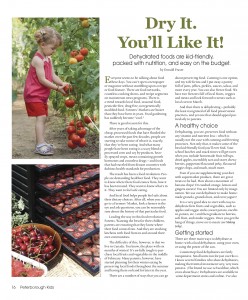New Food Dehydrating Article in Kidz Ink Series of Magazines
 You can find my new article on food dehydration in Peterborough Kids, Lakeridge Kids, and Northumberland Kids magazines. Look for them throughout Peterborough and Northumberland Counties and across Durham Region. Or click on the links. You’ll find it in the August/September editions.
You can find my new article on food dehydration in Peterborough Kids, Lakeridge Kids, and Northumberland Kids magazines. Look for them throughout Peterborough and Northumberland Counties and across Durham Region. Or click on the links. You’ll find it in the August/September editions.
Click on the pictures (below) for full sized images. All photos by Krista Campbell Fraser
Excerpt #1
 It’s awfully tough to purchase local fruits and vegetables in the middle of February.
It’s awfully tough to purchase local fruits and vegetables in the middle of February.
Many parents, however, have started planning for their winter eating by preserving local foods throughout the summer and having them on hand for later in the year.
There are a number of ways that you can go about preserving food. Canning is one option, and my wife Krista and I put away a pantry full of jams, jellies, pickles, sauces, salsas, and more every year.
You can also freeze food. We have two freezers full of local fruits, veggies and meats and look forward to treats such as local corn in March.
And then there is dehydrating – probably the least recognized of all food preservation practices, and yet one that should appeal particularly to parents.
Dehydrating, you see, preserves food without any vitamin and nutrient loss – which is usually not the case with canning and freezing processes.
Not only that, it makes some of the best kid-friendly food you’ll ever find. Your school lunches and snack times will get raves when you include homemade fruit roll-ups, dried apples, incredibly tart and sweet chewy berries, pepperoni-flavoured jerky, flavoured veggie chips, and much, much more.
Even if you are supplementing your diet with supermarket produce, there are great treats to be had. How about a mountain of banana chips? Or candied orange, lemon and gingers sweets? You are limited only by imagination.
We use our dehydrator to make homemade granola, granola bars, and even yogurt!
Find the full article in: Peterborough Kids, Lakeridge Kids, and Northumberland Kids magazines.
Excerpt #2
 Krista spends some good quality time dehydrating each summer – and, in winter, keeping us stocked with granola and veggie chips. She’s compiled a sure-fire list of tips for successful dehydrating:
Krista spends some good quality time dehydrating each summer – and, in winter, keeping us stocked with granola and veggie chips. She’s compiled a sure-fire list of tips for successful dehydrating:
• Cut off any bruised/soft sections of fruit or vegetables.
• Cut food into slices of uniform thickness – a ¼ inch is usually the norm for most foods.
• Spray discolouring foods (such as apples and peaches) with lemon juice (from a spray bottle) to maintain colour in the dried product.
• Leave a bit of space around drying food portions to allow for air flow – no overlapping.
• When making fruit leather, spread a puree of your favourite fruits, evenly until around 1/8 of an inch thick in the centre – very slightly thicker at the edges.
• Let food dry completely before storing to avoid moisture build-up from the cooling process.
• Dehydrate food until leathery or slightly crisp (apples and fruits turn leathery, while veggie chips will crispen up) in order to ensure better storage.
• Store dehydrated food in an airtight bag or container. If kept in a dark, dry cool space, they should last for a number of months – different foods will last for different amounts of time, but a good rule of thumb is to use any summer foods by the end of the following winter. Try to remove as much air as possible from your bags/containers for optimum freshness.
• Keep your counters, drying racks, and kitchen utensils clean – as with any food preparation, you want to avoid contaminants.
Dried foods are not only great for lunches and snacks, but are perfect for camping. We’ll pre-dry an assortment of foods to make great canoe-trip meals, such as soups, chili, and pasta dishes. All you’ll need to do is add is boiling water!
Find the full article in: Peterborough Kids, Lakeridge Kids, and Northumberland Kids magazines.
